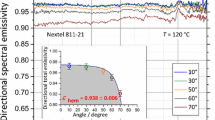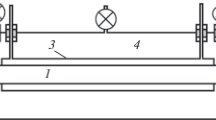Abstract
A new facility of the Physikalisch-Technische Bundesanstalt for emissivity measurements under vacuum was brought into operation, capable of measuring directional spectral emissivity in the wavelength range from \(4\,\upmu \hbox {m}\) to \(100\,\upmu \hbox {m}\) and temperature range from \(-40\,^{\circ }\hbox {C}\) to \(450\,^{\circ }\hbox {C}\). The wide spectral and thermal ranges in combination with a target uncertainty of less than 0.01 meet the needs of the solar thermal energy industry and climate research. Emissivities determined in these ranges and at that uncertainty levels would allow significantly improving solar thermal absorber coatings and designing improved reference blackbodies for remote sensing. Here the measurement scheme which is based on the measurement of the spectral radiance of a sample with respect to the spectral radiance of two blackbodies at different temperatures is presented, and the subsequent evaluation of the emissivity is discussed. The first results of emissivity measurements under vacuum in the wavelength range from \(4\,\upmu \hbox {m}\) to \(100\,\upmu \hbox {m}\) and temperature range from \(-40\,^{\circ }\hbox {C}\) to \(450\,^{\circ }\hbox {C}\) are presented and compared with results obtained in air, and it is shown that samples with very low emissivity can be measured with the required low target uncertainty of less than 0.01.
Similar content being viewed by others
Avoid common mistakes on your manuscript.
1 Introduction
An accurate knowledge of the emissivity of a material is of significant interest for many technological applications. Examples of applications under vacuum which require very low uncertainties of emissivity of less than 0.01, typically 0.005, are absorbers for solar thermal electricity generation [1] and coatings of onboard reference blackbodies for benchmark missions in space [2]. With the new PTB facility, the emittance of samples can be measured under vacuum conditions in the wavelength range from \(4\,\upmu \hbox {m}\) to \(100\,\upmu \hbox {m}\) and temperature range from \(-40\,^{\circ }\hbox {C}\) to \(450\,^{\circ }\hbox {C}\). This facility is part of the Reduced Background Calibration Facility (RBCF) [3] at PTB which allows all critical components of the optical path to be cooled with liquid nitrogen (see Fig. 1). Hereby the background radiation is largely reduced, and consequently the uncertainty of emissivity measurements is reduced as well.
2 Calculation of Emissivity
The measurement scheme is based on a comparison of the spectral radiance of a sample inside a temperature-stabilized spherical enclosure with the spectral radiances of two reference blackbodies at different temperatures. The emissivity can be obtained from the ratio
where \(\tilde{L}_{\mathrm{Sample}} (T_{\mathrm{Sample}} )\) denotes the signal measured from the sample at the sample surface temperature \(T_{\mathrm{Sample}} ,\,\tilde{L}_{\mathrm{BB1}} (T_{\mathrm{BB1}} )_{}\) denotes the signal from the first (“main”) reference blackbody at the temperature \(T_{\mathrm{BB1}} ,\) and \(\tilde{L}_{\mathrm{BB-LN}_2 } (T_{\mathrm{BB-LN}_{2}} )\) denotes the signal from the second reference blackbody at the temperature \(T_{\mathrm{BB-LN}_{2}} .\) As the “main” blackbody, we use either the vacuum low-temperature blackbody (VLTBB) [4] or the vacuum medium-temperature blackbody (VMTBB) [5] depending on the temperature range. The “main” blackbody is usually operated at a temperature close to the radiation temperature of the sample. The measured signal \(\tilde{L}_{\mathrm{BB1}} (T_{\mathrm{BB1}} )\) of this blackbody is given by
The spectral radiance of the blackbody is given by \(L_{\mathrm{BB1}}(T_{\mathrm{BB1}} )=\varepsilon _{\mathrm{BB1}} L_{\mathrm{Planck}} (T_{\mathrm{BB1}} )\), where \(L_{\mathrm{Planck}} (T_{\mathrm{BB1}} )\) is the spectral radiance given by Planck’s law and \(\varepsilon _{\mathrm{BB1}} \) is the effective directional spectral emissivity of the blackbody. \(L_{\mathrm{Background}}\) denotes the spectral radiance of the thermal background of the RBCF and \(L_{\mathrm{Detector}} \), the spectral radiance of the detector. \(s\) is the spectral responsivity of the spectrometer. The second reference source in our experiment, the \(\hbox {LN}_{2}\)-cooled blackbody, is mounted on top of the opto-mechanical unit (see Fig. 1) and is used for the elimination of the background radiation. Its measured signal is given by
The changes with respect to Eq. 2 are the additional radiance of the highly reflective chopper \(L_{\mathrm{Chopper}} (T_{\mathrm{Chopper}})=\varepsilon _{\mathrm{Chopper}} L_{\mathrm{Planck}} (T_{\mathrm{Chopper}} )\) and its directional spectral reflectance \(\rho _{\mathrm{Chopper}} \). These additional terms are due to the design of the RBCF, where the chopper is used to image the radiance of the cold-reference blackbody onto the optical axis. By forming the difference of Eqs. 2 and 3, the terms of the background radiance \(L_{\mathrm{Background}}\) and the detector radiance \(L_{\mathrm{Detector}}\) can be eliminated:
For the recorded signal of the sample \(\tilde{L}_{\mathrm{Sample}}(T_{\mathrm{Sample}} )\) additionally, the radiation emitted by the enclosure of the sample \(\varepsilon _{\mathrm{Encl}}L_{\mathrm{Planck}}(T_{\mathrm{Encl}})\), which is reflected towards the detector by the directional-hemispherical reflectance of the sample \(\rho _{\mathrm{Sample}}=1-\varepsilon _{\mathrm{Sample}} \), has to be considered. Subtracting Eq. 3 from \(\tilde{L}_{\mathrm{Sample}}(T_{\mathrm{Sample}} )\) to eliminate again the terms of the background radiance \(L_{\mathrm{Background}} \) and the detector radiance \(L_{\mathrm{Detector}} \) yields
Furthermore, for highly reflecting and hence low-emitting samples, the radiation emitted by the sample towards the spherical enclosure which is then partly reflected back by the enclosure and via the directional-hemispherical reflectance of the sample partly reflected towards the detector has to be considered as well. For this radiation and also for the radiation originating from the sphere, multiple reflections occur [6]. Depending on the reflectance of the sample, their magnitude can be significant and has to be considered. However, this leads to an extensive expression with multiple sums which is omitted here for clarity.
Finally, the background corrected signals from the blackbody (Eq. 4) and from the sample (Eq. 5) (alternatively, the expression not explicitly given here considering multiple reflections) are substituted into the ratio (Eq. 1) which is then solved for the emittance of the sample. Because all temperatures and all other relevant quantities in the derived expression are recorded during the experiment or known with their corresponding uncertainty [7], the emittance of the sample can be calculated.
3 Experimental Results
As an example, measurements of the directional spectral emittance of a silicon carbide sample at three different temperatures under vacuum are compared in Fig. 2. The measurement at \(-40\,^{\circ }\hbox {C}\) (from \(7\,\upmu \hbox {m}\) to \(18.5\,\upmu \hbox {m}\)) exhibits a higher noise level but shows no systematic deviations to the measurement at \(200\,^{\circ }\hbox {C}\) (from \(5\,\upmu \hbox {m}\) to \(25\,\upmu \hbox {m}\)) within its range of the standard measurement uncertainty. In this temperature range, the temperature variation of the emissivity of SiC is negligible within the measurement uncertainty. Hence, the result illustrates the ability to determine emissivities below \(0\,^{\circ }\hbox {C}\) correctly. At a sample temperature of \(450\,^{\circ }\hbox {C}\), an actual change in the emissivity of SiC in the \(10\,\upmu \hbox {m}\) to \(12\,\upmu \hbox {m}\) range can be detected.
In Fig. 3, an emittance measurement under vacuum in the wavelength range up to \(100\,\upmu \hbox {m}\) of the same sample of silicon carbide is shown. The directional spectral emittance was measured under vacuum at a temperature of \(200\,^{\circ }\hbox {C}\) and compared in the overlapping wavelength range from \(16.7\,\upmu \hbox {m}\) to \(25\,\upmu \hbox {m}\) with the measurements recorded in the wavelength range from \(5\,\upmu \hbox {m}\) to \(25\,\upmu \hbox {m}\). Additionally, these measurements were compared with a measurement performed at the emissivity setup in air [8, 9]. The results show good agreement within their ranges of uncertainty. For the measurements in the wavelength range from \(5\,\upmu \hbox {m}\) to \(25\,\upmu \hbox {m}\), the spectrometer was equipped with a pyroelectric deuterated L-alanine-doped triglycine sulfate (DLaTGS) detector and a potassium bromide (KBr) broadband beamsplitter. In the longer wavelength range up to \(100\,\upmu \hbox {m}\), a pyroelectric far infrared deuterated triglycine sulfate (FDTGS) detector and a multilayer Mylar beamsplitter were used.
Directional spectral emittance of a SiC sample measured under vacuum up to \(100\,\upmu \hbox {m}\) and compared in the overlapping wavelength range from \(16.7\,\upmu \hbox {m}\) to \(25\,\upmu \hbox {m}\) with measurements recorded in the wavelength range from \(5\,\upmu \hbox {m}\) to \(25\,\upmu \hbox {m}\)
Further examples are given in Figs. 4 and 5 showing the emittance of a gold mirror and the range of the standard uncertainty of this measurement. A gold mirror gives an excellent example of a material with very low emissivity and hence is a critical assessment of the capabilities of the RBCF and of the applied method of calculation of the emissivity. The directional spectral emittance of the gold mirror was measured under vacuum at a polar angle of \(15^{\circ }\) and a temperature of \(200\,^{\circ }\hbox {C}\).
In Fig. 4, the emittance measurement under vacuum is compared with a measurement of the same sample at the same temperature performed at the setup in air. Both measurements are compared with the emittance determined indirectly from a specular reflectivity measurement of the same sample obtained under the geometry \(12^{\circ }/12^{\circ }\) with a standard reflection accessory of the RBCF’s Fourier transform infrared (FTIR) spectrometer. All three results agree well within their ranges of uncertainties. The measurement in air shows artifacts around \(1600\,\hbox {cm}^{-1}\) caused by residual water absorption. These artifacts are absent under vacuum; hence, the emittance measurements are undisturbed in this range and the systematic uncertainty is reduced. Furthermore, the hemispherical total emittance of a sample can be determined from a sequence of measurements at different polar angles. As an example, the directional spectral emittance of the gold mirror is shown at angles from \(15^{\circ }\) to \(70^{\circ }\) in Fig. 5. The partially polarized emitted radiation of the slanted sample was not further analyzed for the ratio of the s- and p-components, and the polarization-dependent sensitivity of the spectrometer was neglected for these measurements. The integrated quantities, the directional total emittances, and the hemispherical total emittance, which were calculated from the spectral quantities, are shown in the inset.
4 Conclusion
The PTB performs highly accurate directional spectral emissivity measurement under vacuum in the wavelength range from \(4\,\upmu \hbox {m}\) to \(100\,\upmu \hbox {m}\) and temperature range from \(-40\,^{\circ }\hbox {C}\) to \(450\,^{\circ }\hbox {C}\) at the Reduced Background Calibration Facility. The scheme for direct emissivity measurements under vacuum is based on the measurement of the spectral radiance of a sample inside a temperature-stabilized spherical enclosure with respect to the spectral radiance of two reference blackbodies at different temperatures. The evaluation procedure for low emissivity samples accounts for multiple reflections between the hemispherical enclosure and the sample. Test measurements under vacuum show good agreement with the measurements performed at the setup in air. They exhibit smaller systematic uncertainties resulting from the operation under vacuum conditions, and the cooling of all critical parts of the facility with liquid nitrogen. Due to the enhanced evaluation scheme, samples with very low emissivities can also be measured with sufficient accuracy.
References
A.C.E. Kennedy, Review of Mid- to High-Temperature Solar Selective Absorber Materials (National Renewable Energy Lab, Golden, CO, 2002)
H. Latvakoski, M. Watson, S. Topham, D. Scott, M. Wojcik, G. Bingham, in Infrared Remote Sensing and Instrumentation XVIII, ed. by M. Strojnik, G. Paez, 7808 (San Diego, CA, 2010), pp. 78080X–78080X-12 or Proc. SPIE 7808, 78080X (2010)
C. Monte, B. Gutschwager, S.P. Morozova, J. Hollandt, Int. J. Thermophys. 30, 203 (2009)
S.P. Morozova, N.A. Parfentiev, B.E. Lisiansky, V.I. Sapritsky, N.L. Dovgilov, U.A. Melenevsky, B. Gutschwager, C. Monte, J. Hollandt, Int. J. Thermophys. 29, 341 (2008)
S.P. Morozova, N.A. Parfentiev, B.E. Lisiansky, U.A. Melenevsky, B. Gutschwager, C. Monte, J. Hollandt, Int. J. Thermophys. 31, 1809 (2010)
R.B. Pérez-Sáez, L. del Campo, M.J. Tello, Int. J. Thermophys. 29, 1141 (2008)
A. Adibekyan, C. Monte, M. Kehrt, S.P. Morozova, B. Gutschwager, J. Hollandt, Meas. Tech. 55, 1163 (2013)
C. Monte, J. Hollandt, High Temp. High Press. 39, 151 (2010)
C. Monte, J. Hollandt, Metrologia 47, 172 (2010)
Author information
Authors and Affiliations
Corresponding author
Rights and permissions
About this article
Cite this article
Adibekyan, A., Monte, C., Kehrt, M. et al. Emissivity Measurement Under Vacuum from \(4\,\upmu \hbox {m}\) to \(100\,\upmu \hbox {m}\) and from \(-40\,^{\circ }\hbox {C}\) to \(450\,^{\circ }\hbox {C}\) at PTB. Int J Thermophys 36, 283–289 (2015). https://doi.org/10.1007/s10765-014-1745-7
Received:
Accepted:
Published:
Issue Date:
DOI: https://doi.org/10.1007/s10765-014-1745-7









